Reductive Alkylation Of Amines With Orthocarboxylic Acid Esters
KADYROV; Renat
U.S. patent application number 16/074306 was filed with the patent office on 2020-07-23 for reductive alkylation of amines with orthocarboxylic acid esters. This patent application is currently assigned to Evonik Degussa GmbH. The applicant listed for this patent is Evonik Degussa GmbH. Invention is credited to Renat KADYROV.
| Application Number | 20200231537 16/074306 |
| Document ID | / |
| Family ID | 55359398 |
| Filed Date | 2020-07-23 |








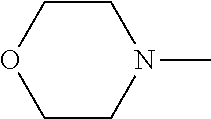



View All Diagrams
| United States Patent Application | 20200231537 |
| Kind Code | A1 |
| KADYROV; Renat | July 23, 2020 |
REDUCTIVE ALKYLATION OF AMINES WITH ORTHOCARBOXYLIC ACID ESTERS
Abstract
The present invention relates to a process for the N-alkylation of amines by reacting an amine with an orthocarboxylic acid ester and with hydrogen in the presence of a hydrogenation catalyst.
| Inventors: | KADYROV; Renat; (Frankfurt, DE) | ||||||||||
| Applicant: |
|
||||||||||
|---|---|---|---|---|---|---|---|---|---|---|---|
| Assignee: | Evonik Degussa GmbH Essen DE |
||||||||||
| Family ID: | 55359398 | ||||||||||
| Appl. No.: | 16/074306 | ||||||||||
| Filed: | January 23, 2017 | ||||||||||
| PCT Filed: | January 23, 2017 | ||||||||||
| PCT NO: | PCT/EP2017/051313 | ||||||||||
| 371 Date: | July 31, 2018 |
| Current U.S. Class: | 1/1 |
| Current CPC Class: | C07D 295/023 20130101; C07C 209/26 20130101; C07C 229/36 20130101; C07C 229/24 20130101; C07C 227/18 20130101; C07D 211/16 20130101; C07D 207/06 20130101; C07D 295/03 20130101; C07D 265/30 20130101; C07C 211/48 20130101; C07C 209/26 20130101; C07C 211/48 20130101; C07C 209/26 20130101; C07C 211/27 20130101; C07C 227/18 20130101; C07C 229/12 20130101; C07C 227/18 20130101; C07C 229/36 20130101; C07C 227/18 20130101; C07C 229/24 20130101 |
| International Class: | C07C 227/18 20060101 C07C227/18; C07D 265/30 20060101 C07D265/30; C07D 207/06 20060101 C07D207/06; C07C 209/26 20060101 C07C209/26; C07D 211/16 20060101 C07D211/16 |
Foreign Application Data
| Date | Code | Application Number |
|---|---|---|
| Feb 3, 2016 | EP | 16154092.7 |
Claims
1-12. (canceled)
13. A process for the N-alkylation of amines or of ammonia, comprising reacting an orthocarboxylic acid ester with an amine or with ammonia and with hydrogen in the presence of a hydrogenation catalyst.
14. The process of claim 13, wherein the reaction takes place in the presence of an acid.
15. The process of claim 14, wherein the reaction takes place at a molar ratio of acid to amine in a range from 0.01:100 to 10:100.
16. The process of claim 13, wherein the reaction takes place at a molar ratio of hydrogenation catalyst to the amine used in a range from 1:10 to 1:100 000.
17. The process of claim 13, wherein the reaction takes place at a hydrogen partial pressure in a range from 0.1 bar to 200 bar.
18. The process of claim 13, wherein the reaction is carried out in a temperature range from 20.degree. C. to 200.degree. C.
19. The process of claim 13, wherein the hydrogenation catalyst is a heterogeneous hydrogenation catalyst.
20. The process of claim 19, wherein the heterogeneous hydrogenation catalyst comprises at least one active metal.
21. The process of claim 20, wherein the active metal is a metal of group VII B and/or VIII B of the Periodic Table of the Elements.
22. The process of claim 13, wherein the reaction takes place in a solvent.
23. The process of claim 22, wherein the solvent is selected from the group consisting of hydrocarbons, chlorohydrocarbons, ethers, esters and alcohols.
24. The process of claim 13, wherein the reaction is carried out without solvents.
25. The process of claim 16, wherein the reaction takes place at a hydrogen partial pressure in a range from 0.1 bar to 200 bar.
26. The process of claim 25, wherein the reaction is carried out in a temperature range from 20.degree. C. to 200.degree. C.
27. The process of claim 16, wherein the hydrogenation catalyst is a heterogeneous hydrogenation catalyst.
28. The process of claim 27, wherein the heterogeneous hydrogenation catalyst comprises at least one active metal.
29. The process of claim 28, wherein the active metal is a metal of group VII B and/or VIII B of the Periodic Table of the Elements.
30. The process of claim 29, wherein the reaction takes place in a solvent.
31. The process of claim 30, wherein the solvent is selected from the group consisting of hydrocarbons, chlorohydrocarbons, ethers, esters and alcohols.
32. The process of claim 29, wherein the reaction is carried out without solvents.
Description
[0001] The present invention relates to a process for the preparation of amines by reductive alkylation of amines or of ammonia by means of orthocarboxylic acid esters in the presence of hydrogen and of a hydrogenation catalyst.
[0002] Amines play a dominant role in numerous complex natural substances such as, for example, the alkaloids, vitamins or amino acids, the chemical, pharmaceutical and industrial importance of which is undeniable. As intermediates, amines are used inter alia in the synthesis of pharmaceuticals, agrochemicals, food additives, dyes or cosmetics. For the field of active ingredients, amino acids play a superior role in this regard.
[0003] Amines can be prepared inter alia by reduction of the corresponding carboxamides, for example by catalytic hydrogenation of carboxamides (M. Stein and B. Breit, Angew. Chem. Int. Ed. 2013, 52, 2231-2234; WO 2015/067450 A1) or by catalytic hydrogenation of amide acetals, ketene N,O-acetals or ester imides (WO 2015/067448 A1).
[0004] A further method, the reductive alkylation of ammonia or of primary or secondary amines by means of aldehydes and ketones, leads in the presence of hydrogen and heterogeneous metal catalysts to an alkylation of the amino group. The reductive alkylation of amines belongs to the most important methods for the preparation of amines (W. S. Emerson, The preparation of amines by reductive alkylation, in Organic Reactions, Vol. 4, 1948, pp. 174-255, Wiley, N.Y.; Catalytic Hydrogenation over Platinum Metals, Academic Press, New York, 1967, p. 291 ff; Catalytic Hydrogenation in Organic Synthesis, Academic Press, New York, 1979, 165 ff; F. Muller and R. Schroter in Methoden Org. Chem. (Houben-Weyl), 1957, XI/1, p. 602-671; S. Nishimura, Handbook of Heterogeneous Catalytic Hydrogenation for Organic Synthesis 2001, pp. 406-411, Wiley, N.Y.). The reaction of aldehydes or ketones with ammonia or primary or secondary amines in the presence of hydrogen and of heterogeneous catalysts, however, generally requires drastic reaction conditions as regards pressure and temperature. By contrast, Riermeier et al. (WO 01/05741 A1) propose a variant of this reaction using homogeneous metal catalysts, in which more mild reaction conditions can be observed.
[0005] The reductive alkylation of amines in the presence of hydrogen with heterogeneous catalysis, however, has further disadvantages. During the synthesis of secondary amines by reaction of primary amines with highly reactive aldehydes, it is generally not possible to stop the reaction at the monoalkylation stage. This often leads to relatively complex product mixtures. Furthermore, the methylation of amines by way of reductive alkylation by means of formaldehyde can generally only take place in aqueous solution, since formaldehyde is obtainable exclusively in aqueous solution (in the form of its hydrate). This presents a greater problem during the reductive methylation of amino acids, since the amino acids readily soluble in water are difficult to isolate from aqueous solution.
[0006] It is therefore an object of the present invention to provide a new type of process for the alkylation of amines which does not have the disadvantages, described above, that have arisen hitherto when using aldehydes as alkylating agents.
[0007] Surprisingly, it has now been found that amines can be alkylated with orthocarboxylic acid esters in the presence of hydrogen and customary hydrogenation catalysts.
[0008] The set object is accordingly achieved by a process for the N-alkylation of amines by reacting an orthocarboxylic acid ester with an amine and with hydrogen in the presence of a hydrogenation catalyst.
[0009] The process according to the invention is thus a process for the preparation of secondary or tertiary amines by reacting an orthocarboxylic acid ester with a primary or secondary amine and with hydrogen in the presence of a hydrogenation catalyst. In a similar way, it is also possible to synthesize primary amines by reacting an orthocarboxylic acid ester with ammonia and with hydrogen in the presence of a hydrogenation catalyst.
[0010] During the reaction of an orthocarboxylic acid ester with an amine and with hydrogen in the presence of a hydrogenation catalyst according to the present invention, the molar ratio of hydrogenation catalyst to the amine used is in a range from 1:10 to 1:100 000. The hydrogen partial pressure is in a range from 0.1 bar to 200 bar. The temperature is set in a range from 20.degree. C. to 200.degree. C.
[0011] It is advantageous to carry out the process according to the invention in the presence of catalytic amounts of an acid.
[0012] In the process according to the present invention, it is possible for example to react amines with the general formula (I) with an orthocarboxylic acid ester of the formula (II) to give N-alkylated amines, where
##STR00001##
the radicals R and R.sup.1 independently of one another are selected from the group consisting of H, or (C.sub.1-C.sub.24)-alkyl, (C.sub.3-C.sub.20)-cycloalkyl, (C.sub.2-C.sub.13)-heterocycloalkyl, (C.sub.6-C.sub.14)-aryl, or (C.sub.3-C.sub.13)-heteroaryl radical that is linear or provided with one or more substituents on any desired carbon atom, with the proviso that R and R.sup.1 are not simultaneously H, and where the radicals R with R.sup.1 can form optionally a saturated or mono- or polyunsaturated (C.sub.2-C.sub.18)-alkylene or (C.sub.2-C.sub.18)-heteroalkylene bridge, so that a ring with in total 3-20 ring atoms is formed, and where
[0013] R.sup.2 is selected from the group consisting of H, (C.sub.1-C.sub.24)-alkyl, (C.sub.3-C.sub.20)-cycloalkyl, (C.sub.2-C.sub.13)-heterocycloalkyl, (C.sub.6-C.sub.14)-aryl, (C.sub.3-C.sub.13)-heteroaryl and
[0014] R.sup.3, R.sup.4 and R.sup.5 independently of one another are selected from the group consisting of H, (C.sub.1-C.sub.24)-alkyl, (C.sub.3-C.sub.8)-cycloalkyl or (C.sub.6-C.sub.14)-aryl, where both the radicals R.sup.2 with R.sup.3, as well as R.sup.3 with R.sup.4 independently of one another can form a saturated or mono- or polyunsaturated (C.sub.2-C.sub.18)-alkylene or (C.sub.2-C.sub.18)-heteroalkylene bridge, such that a ring with in total 3-20 ring atoms is formed.
[0015] R.sup.2 is preferably selected from the group consisting of H, (C.sub.1-C.sub.24)-alkyl, phenyl.
[0016] R.sup.2 is particularly preferably selected from H, methyl, ethyl, n-propyl, n-butyl, iso-butyl, n-pentyl, n-hexyl, cyclohexyl, n-heptyl, n-octyl, phenyl.
[0017] R.sup.3, R.sup.4 and R.sup.5 are preferably selected from the group consisting of methyl, ethyl, n-propyl, iso-propyl, n-butyl, iso-butyl, n-pentyl, n-hexyl, n-heptyl, n-octyl, and phenyl.
[0018] A ring is formed preferably between the radicals R.sup.2 and R.sup.3 or R.sup.3 and R.sup.4, where the ring is preferably aliphatic and has the alkylene groups propanedi-1,3-yl, butanedi-1,4-yl, pentanedi-1,5-yl or hexanedi-1,6-yl, such that the ring contains in total 4, 5, 6, 7 or 8 ring atoms.
[0019] The optional substituents on the radicals R and R.sup.1 of the amine of the formula (I) are selected from the group consisting of halogens such as F, Cl, Br, I, and heteroatom-containing functional groups, which contain one or more atoms selected from the group consisting of N, O, P, S, or Si, with single or multiple substitution being possible. Examples of heteroatom-containing functional groups are carbonyl, carboxyl, sulphonate, phosphonate, hydroxyl, amino, ammonium groups such as
[0020] --OH,
[0021] -(C.sub.1-C.sub.8)-alkyloxy
[0022] --COOH,
[0023] --NH({C.sub.1-C.sub.8}-acyl),
[0024] --NH({C.sub.1-C.sub.8}-acyloxy)
[0025] --N((C.sub.1-C.sub.20)-alkyl)({C.sub.1-C.sub.8}-acyl),
[0026] --N({C.sub.6-C.sub.14}-aryl)({C.sub.1-C.sub.8}-acyl),
[0027] --N({C.sub.6-C.sub.14}-aralkyl)({C.sub.1-C.sub.8}-acyl),
[0028] --N({C.sub.1-C.sub.8}-acyl).sub.2,
[0029] --NH.sub.3.sup.+,
[0030] --NH({C.sub.1-C.sub.20}-alkyl).sub.2.sup.+,
[0031] --NH({C.sub.6-C.sub.14}-aryl).sub.2.sup.+,
[0032] --NH({C.sub.6-C.sub.14}-aralkyl).sub.2.sup.+,
[0033] --NH({C.sub.1-C.sub.20}-alkyl)({C.sub.6-C.sub.14}-aryl).sup.+,
[0034] --N({C.sub.6-C.sub.14}-aryl)({C.sub.1-C.sub.20}-alkyl).sub.2.sup.+,
[0035] --N({C.sub.6-C.sub.14}-aryl).sub.2({C.sub.1-C.sub.20}-alkyl).sup.+,
[0036] --O--C(.dbd.O)--O-{C.sub.1-C.sub.20}-alkyl,
[0037] --O--C(.dbd.O)--O-{C.sub.6-C.sub.14}-aryl,
[0038] --O--C(.dbd.O)--O-{C.sub.6-C.sub.14}-aralkyl,
[0039] --NH--C(.dbd.O)--O-{C.sub.1-C.sub.20}-alkyl,
[0040] --NH--C(.dbd.O)--O-{C.sub.6-C.sub.14}-aryl,
[0041] --NH--C(.dbd.O)--O-{C.sub.6-C.sub.14}-aralkyl,
[0042] --O--C(.dbd.O)--NH-{C.sub.1-C.sub.20}-alkyl,
[0043] --O--C(.dbd.O)--NH-{C.sub.6-C.sub.14}-aryl,
[0044] --O--C(.dbd.O)--NH-{C.sub.6-C.sub.14}-aralkyl,
[0045] --CN,
[0046] --SO.sub.2--O-{C.sub.1-C.sub.20}-alkyl,
[0047] --SO.sub.2--O-{C.sub.6-C.sub.14}-aryl,
[0048] --SO.sub.2--O-{C.sub.6-C.sub.14}-aralkyl,
[0049] --SO.sub.2-{C.sub.1-C.sub.20}-alkyl,
[0050] --SO.sub.2-{C.sub.6-C.sub.14}-aryl,
[0051] --SO.sub.2-{C.sub.6-C.sub.14}-aralkyl,
[0052] --SO-{C.sub.1-C.sub.20}-alkyl,
[0053] --SO-{C.sub.6-C.sub.14}-aryl,
[0054] --SO-{C.sub.6-C.sub.14}-aralkyl,
[0055] --Si({C.sub.1-C.sub.20}-alkyl).sub.3,
[0056] --Si({C.sub.6-C.sub.14}-aryl).sub.3,
[0057] --Si({C.sub.6-C.sub.14}-aryl)({C.sub.1-C.sub.20}-alkyl).sub.2,
[0058] --Si({C.sub.6-C.sub.14}-aryl).sub.2({C.sub.1-C.sub.20}-alkyl),
[0059] -{C.sub.1-C.sub.20}-perfluoroalkyl,
[0060] --PO(O-{C.sub.1-C.sub.20}-alkyl).sub.2,
[0061] --PO(O-{C.sub.6-C.sub.14}-aryl).sub.2,
[0062] --PO(O-{C.sub.1-C.sub.20}-alkyl)(O-{C.sub.6-C.sub.14}-aryl),
[0063] --PO({C.sub.1-C.sub.20}-alkyl).sub.2,
[0064] --PO({C.sub.6-C.sub.14}-aryl).sub.2,
[0065] --PO({C.sub.1-C.sub.20}-alkyl)({C.sub.6-C.sub.14}-aryl).
[0066] The amine of the general formula (I) is for example an amino acid, for example one of the twenty proteinogenic amino acids or an amino acid derivative, for example an amino acid ester, such as e.g. the methyl or ethyl ester of glycine, alanine, valine, leucine, isoleucine, phenylalanine, aspartic acid, glutamic acid, tryptophan or of proline.
[0067] The orthocarboxylic acid ester of the general formula (II) is for example trimethyl orthoformate or triethyl orthoformate, trimethyl orthoacetate or triethyl orthoacetate, trimethyl orthopropanoate or triethyl orthopropanoate, trimethyl orthobutanoate or triethyl orthobutanoate.
[0068] Orthocarboxylic acid esters are inexpensive and the preparation methods are well established (H. Lebel, M. Grenon in Science of Synthesis, Vol. 22, 2005, pp. 669-747; G. Simchen in Methoden Org. Chem. (Houben-Weyl), 1985, E5/1, p. 3-192; R. DeWolf, Synthesis, 1974, 153-172). For example, they can be synthesized by alcoholysis of nitriles with alcohols under acid catalysis:
R.sup.2CN+3R.sup.3OH+HCl.fwdarw.R.sup.2-C(OR.sup.3).sub.3+NH.sub.4Cl
[0069] Orthoformic acid esters can be prepared from chloroform and the sodium alcoholates of the corresponding alcohols (W. E. Kaufmann, E. E. Dreger: Ethylorthoformate [Ethyl orthoformates]. In: Organic Syntheses. 5, 1925, p. 55).
[0070] Orthocarboxylic acid esters with different alcohol radicals (R3.noteq.R4.noteq.R5) can be prepared for example by transesterification.
[0071] Hydrogenation catalysts selected may be all hydrogenation catalysts contemplated by the person skilled in the art for this purpose.
[0072] Preference is given to using heterogeneous hydrogenation catalysts which contain at least one active metal. Preferably, the active metal is one of groups VII B and/or VIII B of the Periodic Table of the Elements, with precious metals and Ni being preferred, and Ru, Rh, Pd, Pt, Re and Ni being particularly preferred. The metals can be present in the hydrogenation catalyst either (a) as such or in the form of metal oxides or (b) as metal complexes.
[0073] In case (a), the metal or metal oxide can either be applied to a support or be used as particles. For the support material, there are no limitations. Usually, customary supports such as aluminium oxide, silicon dioxide, aluminium oxide, iron oxide, magnesium oxide, zirconium dioxide, carbon or similar supports known to the person skilled in the field of hydrogenation are used. The content of metal or metal oxide on the support is selected within a range from 1% by weight to 25% by weight, based on the total weight of the catalyst. Preferably, a content of 1% to 5% by weight of metal or metal oxide on the support is selected.
[0074] Examples of such hydrogenation catalysts are Pt/C, Pd/C, Ru/C, Rh/C, Pd/CaCO.sub.3, Pd/Al.sub.2O.sub.3, Ru/Al.sub.2O.sub.3, Rh/Al.sub.2O.sub.3, Pd/Re/C, Pt/Re/C, RuO.sub.2.
[0075] In case (b), the metals can also be used in the form of metal complexes as hydrogenation catalysts. Examples thereof are metal complexes of the metals Rh, Ir or Ru, such as e.g. the Wilkinson catalyst CIRh(PPh.sub.3).sub.3 or [(dppb)Rh(cod)]BF.sub.4, [Ir(PCy.sub.3(C.sub.5H.sub.5N)(cod)]PF.sub.6, [Cl.sub.2Ru(PPh.sub.3).sub.3] and [(dppb)Ru(metallyl).sub.2].
[0076] Preferably, the hydrogenation catalyst is selected from the group consisting of Pd/C, Pd/Al.sub.2O.sub.3, Pd/CaCO.sub.3, Pt/C, Ru/Al.sub.2O.sub.3, Ru/C, Rh/C and [(dppb)Rh(cod)]BF.sub.4. Particularly preferably, the hydrogenation catalyst is selected from the group consisting of 5% Pd/C, 5% Pd/Al.sub.2O.sub.3, 5% Pd/CaCO.sub.3, 5% Pt/C, 5% Ru/Al.sub.2O.sub.3, 5% Ru/C, 5% Rh/C and [(dppb)Rh(cod)]BF.sub.4.
[0077] The amount of hydrogenation catalyst can be freely selected by the person skilled in the art, where the molar ratio of hydrogenation catalyst to amine is in a range from 1:10 to 1:100 000. Further preference is given to a range from 1:20 to 1:10 000, particular preference being given to a range from 1:50 to 1:2000.
[0078] In principle, the person skilled in the art is free to select the solvent that he would like to use in the process according to the invention. On account of the fact that the starting materials are often present in liquid form, it is in this regard also possible to dispense with using a solvent. If, however, the use of solvents in the process according to the invention is desired, it is advantageous to use those solvents which accordingly readily dissolve the components of the reaction used and otherwise have proven to be inert towards the reaction according to the invention. Examples include polar or nonpolar solvents, in particular inter alia hydrocarbons, chlorohydrocarbons, ethers, esters and alcohols. Preference is given here to alkanes, haloalkanes, monohydric and polyhydric alcohols, cyclic and acyclic ethers, and esters.
[0079] Preferred solvents are those selected from the group consisting of hexane, heptane, octane, dimethyl glycol ether (DMGE), 1,4-dioxane, methyl tert-butyl ether (MTBE), tetrahydrofuran (THF), ethyl acetate, isopropyl acetate, dibutyl ether, dimethyl carbonate, diethyl carbonate, dipropyl carbonate, methanol, ethanol, isopropanol, butanol, ethylene glycol, dichloromethane and 1,2- dichloroethane. Particular preference is given to methanol and ethanol.
[0080] During the reaction, the hydrogen partial pressure of the reaction is established in a range from 0.1 to 200 bar, preferably from 0.1 to 100 bar, and particularly preferably from 0.1 to 60 bar.
[0081] The temperature which is to be established during the reaction can be determined by the person skilled in the art and is usually in a range from 0.degree. C. to 250.degree. C. It should be high enough that the envisaged reaction proceeds in a sufficiently rapid time but be as low as possible so that the by-product spectrum during the hydrogenation can be kept as low as possible. Preferably, a temperature in the range from 20.degree. C. to 200.degree. C., preferably in a range from 20.degree. C. to 150.degree. C. is established. Particularly preferably, a temperature in the range from 100.degree. C. to 130.degree. C. is established, and very particularly preferably a temperature in the range from 110.degree. C. to 130.degree. C. is established.
[0082] In a particular embodiment of the process according to the invention, the hydrogenation catalyst comprises an active metal.
[0083] In a further particular embodiment of the invention, the active metal is a metal of group VII B and/or VIII B of the Periodic Table of the Elements.
[0084] In a further particular embodiment of the invention, the reaction furthermore takes place in the presence of an acid. The amount of acid can be freely chosen by the person skilled in the art. However, the acid is preferably used in a molar ratio in a range from 0.01:100 to 10:100, based on the amine.
[0085] In principle, the person skilled in the art is free to choose a suitable acid. Preferably, however, cost-effective inorganic or organic acids are used. Preference is given to acids which are selected from the group consisting of mineral acids, carboxylic acids, arylsulphonic acids, alkanesulphonic acids, fluorosulphonic acid. Acids which are selected from the group consisting of p-toluenesulphonic acid (4-MeC.sub.6H.sub.4SO.sub.2OH), CF.sub.3SO.sub.2OH, CH.sub.3SO.sub.2OH, CF.sub.3COOH, ClCH.sub.2COOH, CH.sub.3COOH and HCOOH are particularly preferred in this connection.
[0086] A particular embodiment of the process according to the invention is that the reaction is carried out in a solvent.
[0087] The solvent is preferably selected from the group consisting of hydrocarbons, chlorohydrocarbons, ethers, esters and alcohols.
[0088] A further embodiment of the process according to the invention is that the reaction is carried out without solvents.
[0089] It is advantageous to work in the absence of water. The invention therefore further provides a process according to the present invention, where anhydrous amine and anhydrous orthocarboxylic acid ester and optionally anhydrous solvent are used.
[0090] In the process according to the invention, the procedure generally involves mixing, in an autoclave, the amine, the orthocarboxylic acid ester and the catalyst in a certain molar ratio with a suitable amount of solvent. Then, the autoclave is flushed several times with hydrogen and heated to the reaction temperature and the mixture is hydrogenated at a suitable pressure. After cooling, the hydrogen pressure is let down, the reaction mixture is filtered off and the filtrate is worked up by processes known to the person skilled in the art.
[0091] In a preferred embodiment of the process according to the invention, the procedure generally involves mixing, in an autoclave, the amine and the orthocarboxylic acid ester with a suitable amount of solvent and acid. Then, the catalyst is added in a certain molar ratio, the autoclave is flushed several times with hydrogen and the mixture is hydrogenated at a suitable temperature and suitable pressure. After the cooling, the hydrogen pressure is let down, the reaction mixture is filtered off and the filtrate is worked up by a process known to the person skilled in the art.
[0092] In a particularly preferred embodiment of the process according to the invention, the procedure generally involves mixing, in an autoclave, the amine and the orthocarboxylic acid ester with a suitable amount of acid. Then, the catalyst is added in a certain molar ratio, the autoclave is flushed several times with hydrogen and the mixture is hydrogenated at a suitable temperature and suitable pressure. After cooling, the hydrogen pressure is let down, the reaction mixture is filtered off and the filtrate is worked up by a process known to the person skilled in the art.
EXAMPLES
General Procedure for the Reductive Alkylation of Amines with Orthocarboxylic Acid Esters
[0093] An autoclave was filled with catalyst (1 mol % based on the molar amount of amine), flushed with argon and topped up with a solution of amine (0.1 mol) and orthocarboxylic acid ester (0.11-0.3 mol) in 10 ml of methanol (or ethanol) and 0.5 ml of a 0.2 M solution of anhydrous p-toluenesulphonic acid in methanol (or ethanol). The mixture was heated to 120.degree. C. and hydrogen was injected to 40 bar and then the mixture was stirred at a constant pressure until hydrogen absorption could no longer be detected (0.2-6 h). After being filtered off from the catalyst, the filtrate was distilled.
[0094] The yields can be found in Table 1.
TABLE-US-00001 TABLE 1 Yields in the reductive alkylation of amines with orthocarboxylic acid esters. Orthocar- Ex- Orthocar- boxylic ample boxylic acid ester/ Hydrogenation Time, Yield No. acid ester Amine Product amine catalyst [h] [%] 1 HC(OMe).sub.3 ##STR00002## ##STR00003## 2.5 3% Pt/C 3 99 2 HC(OMe).sub.3 ##STR00004## ##STR00005## 2.5 5% Ru/Al.sub.2O.sub.3 5 98 3 HC(OMe).sub.3 ##STR00006## ##STR00007## 2.5 [(dppb)Rh(COD)]BF.sub.4 6 83 4 HC(OMe).sub.3 ##STR00008## ##STR00009## 2.5 5% Pd/C 1 92 5 HC(OMe).sub.3 ##STR00010## ##STR00011## 2.5 5% Pt/C 0.2 97 6 HC(OMe).sub.3 ##STR00012## ##STR00013## 2.5 5% Ru/C 0.3 96 7 HC(OMe).sub.3 ##STR00014## ##STR00015## 2.5 5% Rh/C 0.3 98 8 EtC(OEt).sub.3 PhNH.sub.2 ##STR00016## 1.1 3% Pt/C 1 66 9 n-BuC(OEt).sub.3 ##STR00017## ##STR00018## 1.3 5% Pd/C 1 81 10 n-BuC(OEt).sub.3 ##STR00019## ##STR00020## 1.3 5% Pt/C 0.2 95 11 n-BuC(OEt).sub.3 ##STR00021## ##STR00022## 1.3 5% Ru/C 0.2 90 12 n-BuC(OEt).sub.3 ##STR00023## ##STR00024## 1.3 5% Rh/C 0.2 86 13 PhC(OEt).sub.3 ##STR00025## ##STR00026## 1.1 3% Pt/C 1 93 14 PhC(OEt).sub.3 ##STR00027## ##STR00028## 1.1 5% Rh/C 1 81 15 HC(OEt).sub.3 ##STR00029## ##STR00030## 3 5% Pd/C 1 99 16 HC(OEt).sub.3 ##STR00031## ##STR00032## 3 5% Pt/C 0.5 99 17 EtC(OMe).sub.3 ##STR00033## ##STR00034## 1.2 5% Pd/C 2 64 18 EtC(OMe).sub.3 ##STR00035## ##STR00036## 1.2 5% Pt/C 1 69 19 EtC(OMe).sub.3 ##STR00037## ##STR00038## 1.2 5% Pd/C 1 82 20 EtC(OMe).sub.3 ##STR00039## ##STR00040## 1.2 5% Pt/C 0.1 75 21 EtC(OMe).sub.3 ##STR00041## ##STR00042## 1.2 5% Ru/C 0.5 71 22 EtC(OMe).sub.3 ##STR00043## ##STR00044## 1.2 5% Rh/C 0.1 85 23 EtC(OMe).sub.3 ##STR00045## ##STR00046## 1.2 5% Pt/C 0.1 83 24 EtC(OMe).sub.3 ##STR00047## ##STR00048## 1.2 5% Ru/C 0.2 84 25 EtC(OMe).sub.3 ##STR00049## ##STR00050## 1.2 5% Rh/C 0.2 90 26 EtC(OMe).sub.3 ##STR00051## ##STR00052## 1.2 5% Ru/C 0.5 93 27 EtC(OMe).sub.3 ##STR00053## ##STR00054## 1.2 5% Rh/C 0.1 95 28 HC(OMe).sub.3 ##STR00055## ##STR00056## 3 5% Pd/C 0.5 98 29 HC(OMe).sub.3 ##STR00057## ##STR00058## 3 5% Pt/C 0.1 99 30 HC(OMe).sub.3 ##STR00059## ##STR00060## 3 5% Ru/C 0.3 98 31 HC(OMe).sub.3 ##STR00061## ##STR00062## 3 5% Rh/C 0.3 97 32 EtC(OMe).sub.3 ##STR00063## ##STR00064## 2 5% Pt/C 0.3 90 33 HC(OEt).sub.3 ##STR00065## ##STR00066## 2 5% Pd/C 0.5 82 34 HC(OEt).sub.3 ##STR00067## ##STR00068## 2 5% Pt/C 0.2 90 35 HC(OEt).sub.3 ##STR00069## ##STR00070## 2 5% Ru/C 0.3 88 36 HC(OEt).sub.3 ##STR00071## ##STR00072## 2 5% Rh/C 0.3 87
* * * * *












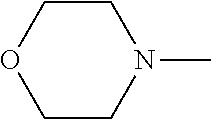

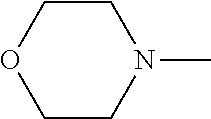



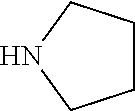







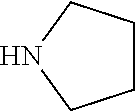
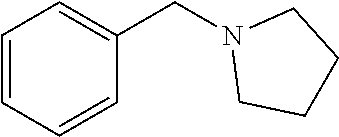
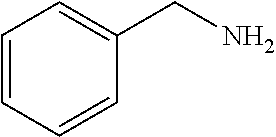
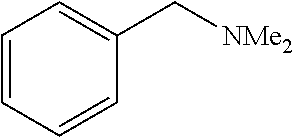


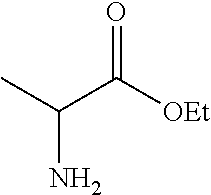
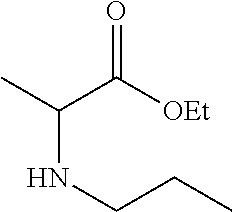















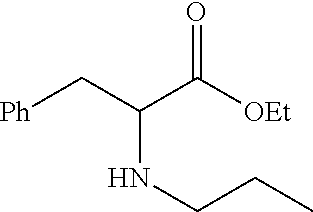



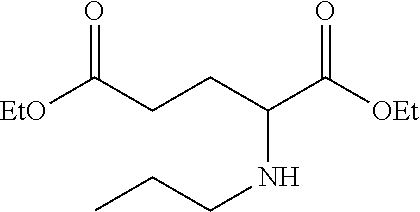
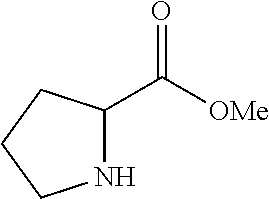
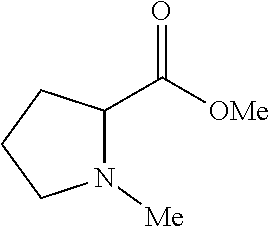

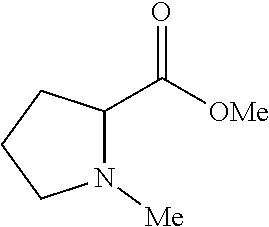
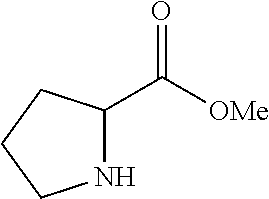
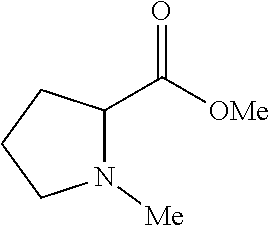
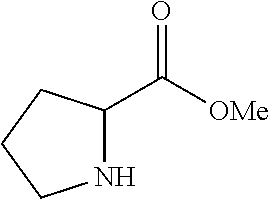
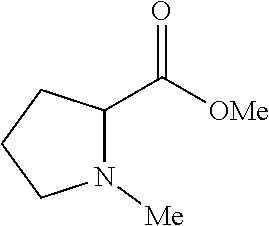




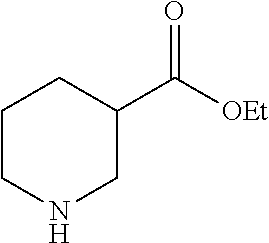

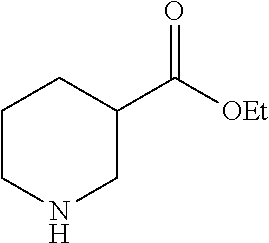



XML
uspto.report is an independent third-party trademark research tool that is not affiliated, endorsed, or sponsored by the United States Patent and Trademark Office (USPTO) or any other governmental organization. The information provided by uspto.report is based on publicly available data at the time of writing and is intended for informational purposes only.
While we strive to provide accurate and up-to-date information, we do not guarantee the accuracy, completeness, reliability, or suitability of the information displayed on this site. The use of this site is at your own risk. Any reliance you place on such information is therefore strictly at your own risk.
All official trademark data, including owner information, should be verified by visiting the official USPTO website at www.uspto.gov. This site is not intended to replace professional legal advice and should not be used as a substitute for consulting with a legal professional who is knowledgeable about trademark law.